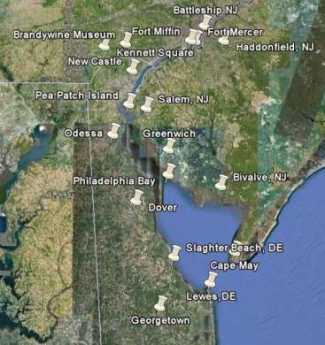Related Topics
Land Tour Around Delaware Bay
 Start in Philadelphia, take two days to tour around Delaware Bay. Down the New Jersey side to Cape May, ferry over to Lewes, tour up to Dover and New Castle, visit Winterthur, Longwood Gardens, Brandywine Battlefield and art museum, then back to Philadelphia. Try it!
Start in Philadelphia, take two days to tour around Delaware Bay. Down the New Jersey side to Cape May, ferry over to Lewes, tour up to Dover and New Castle, visit Winterthur, Longwood Gardens, Brandywine Battlefield and art museum, then back to Philadelphia. Try it!
Reminiscences
"The past is never dead. It's not even past." -- William Faulkner, Requiem for a Nun
Remember This Date: May 18
 Delaware Bay is teeming with successive migrations of seafood. May 18 is a pivotal day, give or take a few days. 
|
| Dr. Fisher |
A group of Texas and California friends were recently led on a two-day tour around lower Delaware Bay, down the New Jersey side to Cape May, ferry ride to Lewes on the Delaware side of the bay, and then home. The timing of this adventure had more to do with azalea and dogwood season than wildlife, but the date chosen was very fortunate: May 18.
It just happens that May 18 is the last day of the shad season. That's dictated by Mother Nature of course, but it also has a lot to do with Dill's Seafood in Bridgeton. For almost a century, this wholesale seafood store has dominated the shad business in the region. At one time, they shipped six thousand pounds of shad daily in season, although in recent years the business has dropped to five hundred pounds a day. Even today that's a lot of fish, supplying boned shad and roe to every restaurant with shad pretensions for a hundred miles around. They do have a restaurant attached, with pitchers of cold beer on the table, and enthusiasts in great numbers.
The source of this monopoly is a very large family of Italian sisters, who have developed the skill of de-boning shad in about thirty seconds. Shad are just about inedible with the bones intact, and most amateurs make a mess of the matter if they try to de-bone the fish themselves. As the supply has dwindled, few people develop the skill needed to compete with these ladies, and the seafood industry has just surrendered the field to them. Although shad have been successfully transplanted to Oregon, the fish is native to the Atlantic Coast, and my Western visitors had never heard of them. What's really special is to fry or bake the half-pound roe sacs, with bacon of course. Shad roe with bacon and beer, now there's really something to talk about. Shad start to "come in" in January, and the last day of the season, the very last day, is May 18.
We then took a forty-minute ferry ride from Cape May to Lewes Delaware, thirty minutes out of sight of land. The reports in the taprooms of Lewes were that no one had yet seen any horseshoe crabs, it was apparently too early for them. But we had passed the point of no return, so we went on to Slaughter Beach. The origin of the name of this beach is obscure as far as local residents are concerned, although it is fun to remember that these were pirate coves in the Sixteenth Century. Captain Kidd, no less. It is also the place where salt water generally turns fresh, depending on the season and the rainfall, a matter of great importance to migrating fish who tend to hang up here in great abundance.
Well, May 19 turned out to be the first day of the season for horseshoe crabs, so our luck was doubly fulfilled. These terribly ugly brown rascals are about the size of a dinner plate, with a long pointed tail, and they come tumbling in on the surf upside down and sideways. Thousands of them are coming, but on the first day, there was a pair of them every six feet or so. This is the famous limulus, which is really more closely related to scorpions than crabs. The tail doesn't seem to have poison, but it is razor-sharp as my younger son discovered when he picked one up by the tail to throw him (?her?) back into the ocean. He got a deep bloody gash for his reward.
The Limulus isn't edible, but it has its uses. It has four eyes, each attached to a single large nerve fiber, making it very useful for ophthalmology and neurology experiments. Its blood is blue since it uses copper instead of iron in its hemoglobin. That hasn't been put to any use, but the blood has a peculiar ability to clot when it comes in contact with bacterial toxins and has proved very useful for identifying toxic bacteria.
As far as amateurs are concerned, the horseshoe crabs attract a mob of seagulls, but we are assured that these are very special birds who take off from South America months earlier. They are said to arrive almost precisely when the crabs do and love to eat the eggs. One female crab produces twenty to fifty thousand eggs. As you approach the line of feasting birds, the near ones take off but the others remain, so the edge of the flock recedes as fast as you approach it. The vacated beach is peppered with the backs of the half-buried crabs, quite touchingly paired off, two by two. Inevitably, the question is raised how a male tells which one is a female. And inevitably the reply is, "That's his problem."
Originally published: Sunday, May 20, 2007; most-recently modified: Monday, June 03, 2019